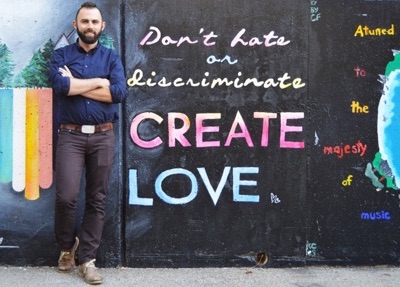Campus News
The new queer teenager
Queer youth today are in a paradoxical situation, coming out earlier and becoming leaders even as they cope with the significant challenges of adolescence, Psychology Professor Phil Hammack told a panel convened by the National Academies of Science, Engineering, and Medicine.

Queer youth today are in a paradoxical situation: The average age of coming out has dropped to 14 as teens courageously challenge labels of gender and sexual identity. But these young trailblazers are becoming leaders even as they cope with the significant challenges of adolescence. LGBTQ youth are experiencing high levels of depression and suicidal behavior, and they need resources and support to overcome the strain.
That’s the message Psychology Professor Phil Hammack delivered to the National Academies of Science, Engineering, and Medicine during a recent Washington, D.C., panel discussion focused on “Adolescents in the 21st Century.”
“There’s a revolution taking place in how people are thinking and talking about gender and sexuality, and the revolution is coming from the bottom up. Teenagers are leading the way,” Hammack said after his June 6 appearance. “They are reaping the benefits of expressing themselves more authentically, but they are feeling the burden of educating adults in their schools, families, and culture.”
Today’s youth are challenging binary thinking and labeling in ways that are leading to an explosion of freedom in identification, said Hammack, a social psychologist at the forefront of scholarship about queer youth. Hammack was invited to participate on a panel focused on the impact of societal and contextual changes on youth; his remarks reflected his findings from an in-depth study of more than 300 queer youth in five California counties.
“It’s not just gay/straight, and it’s not just male/female,” said Hammack.
“Labels have always been constraining. Binary thinking forced people into boxes. Young people aren’t identifying with those categories.”
The internet and social media have enabled queer youth to find each other, giving rise to a community that hasn’t been available to prior generations, he said.
In Hammack’s research, 24 percent of LGBTQ teens identify as gender non-binary, an identity that signals feeling neither male nor female. Fully 71 percent of teens identify with a non-binary sexual identity, such as pansexual, bisexual, or queer.
“Our ideas about sexuality and gender are changing rapidly, and researchers, teachers, parents, clinicians, and policy makers are lagging behind,” said Hammack.
And yet, queer youth are reporting a lot of distress as they face society’s persistent stigmas, said Hammack.
“This is the paradox of the cultural change we’re seeing,” he said. “Young people come out at younger ages and are more courageous and creative about their identities. But this is happening during a developmental period—adolescence—that we know is dominated by concerns about peer influence and fitting in. Queer youth continue to experience the stigma of being ‘different.’ “
LGBTQ youth are twice as likely as straight teens to experience bullying and harassment, and being stigmatized is linked to huge disparities in mental health, said Hammack. Queer youth experience depression at twice the rate of the adolescent population, and lifetime suicidal behavior is nearly eight times more common among queer youth, he said.
But support makes a powerful difference, according to Hammack’s research. Supportive families, schools, and communities—including online communities—are associated with better mental health outcomes for queer youth.
“The root cause of suffering is the myth that heterosexuality is the ideal/normal, that cisgender identity is the norm,” said Hammack, using the term that refers to people whose sense of gender identity matches the sex they were assigned at birth.
Hammack identified several “action items” to support the social and psychological needs of LGBTQ youth, including:
- A broader societal narrative about sexual and gender identity;
- Broadening school curricula to reflect the diversity of sexual and gender diversity;
- Adopt anti-bullying programs that explicitly address sexual expression and gender identity, and support nondiscrimination laws that protect LGBTQ students;
- Financial support for programs and groups that support queer youth, including gay-straight alliances in schools and community-based organizations
Participating on the National Academies’ panel felt like a privilege and a responsibility, said Hammack, who spent the 2017-18 year as a fellow of the Center for Advanced Study in the Behavioral Sciences at Stanford University. “This is a highly influential institution in a place that could actually make a difference in terms of policy and funding,” he said. “I felt privileged. I wanted to do justice to the work and the youth.”